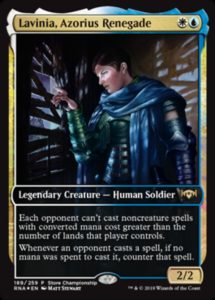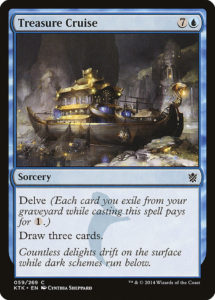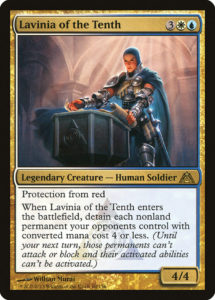Yesterday, Ravnica Allegiance spoilers began in earnest. This week (and possibly today), we’ll learn what the new Azorius mechanic is. In the meantime, let’s take a look at a fascinating new design, Lavinia, Azorius Renegade.
What does she do?
Lavinia, Azorius Renegade is the newest addition in a long and venerable line of hatebears, (usually) 2/2s for two that make your opponents’ lives harder in some way. (In fact, she’s not the only hatebear in Ravnica Allegiance, as Tithe Taker marries Thalia, Guardian of Thraben‘s taxing with Grand Abolisher protecting your turn.)
Lavinia seems to be one of the more ‘fair’ hatebears in that she punishes your opponents for doing broken things like cheating on mana costs or casting free spells. Other hatebears, like Leonin Arbiter punish the very playing of fetchlands, or like Thalia, Guardian of Thraben, all noncreature spells. However, Lavinia does one very important thing most hatebears don’t, something that even her clear antecedent Gaddock Teeg fails to do: she only gets in your opponents’ way. This is potentially huge: in Legacy, she forces your opponents’ Force of Wills to be cast for full retail value, prevents a Miracled Terminus unless they have a whopping six lands in play, and keeps storm from actually casting a Storm card until they’ve at least hit turn four. But she still lets you cast Force of Will; heck, she even pitches extra copies to it.
In Modern, Lavinia stops Tron from casting an early Karn Liberated (but not Walking Ballista or Wurmcoil Engine), prevents Storm from accelerating out a Gifts Ungiven or Past in Flames (but can’t stop Grapeshot), and protects Humans from Terminus (but not Path to Exile). Oh, and she can seriously hurt decks that rely on free or zero-cost spells like Living End, Mox Opal, or Summoner’s Pact. She does a bunch of the work that Damping Sphere does, but while she’s not as good at much of it, she is a 2/2 instead of a do-nothing artifact—a far better fail case.
It’s difficult for cards to make an impact in nonrotating formats, particularly Legacy, but we’ve seen quite a few changes in all formats lately. Lavinia, Azorius Renegade could definitely shift the scene, whether from the sideboard or even in the main deck of something like Humans or Miracles.
What does she hint at?
Lavinia is a potent hoser, but if she’s intended for Standard play, it’s not abundantly clear just what she’s supposed to be combating. There are few cost reduction mechanics in Standard, nor is the format rife with free spells, pitch spells, or powerful zero-cost cards. Sure, she makes Convoke spells like March of the Multitudes and Conclave Tribunal weaker, but she does nothing against Dominarian kicker spells or Jump-started Izzet spells, and most of the ramping in the format is Llanowar Elves accelerating out Lavinia-ignoring creature spells.
Lavinia suggests that we may soon see a cost reduction mechanic or spells with alternate costs. Wizards of the Coast knows full well just how dangerous and powerful free spells like Force of Will and Fireblast (or even Snapback) are. Powerful cost reduction mechanics like Delve can wreak havoc upon nonrotating formats, something Play Design hopes to avoid where possible. It’s exciting knowing that there might be some new cycle of cards that circumvent mana costs, either with alternate costs or cost reduction.
Or Lavinia is akin to one of the many nonrotating-intended cards of Core 2019. You know, cards like Isolate, Alpine Moon, Amulet of Safekeeping, Infernal Reckoning, Elvish Clancaller, Mistcaller, or Supreme Phantom which were all designed to be played in Modern or Legacy, or the Elder Dragon Legends which clearly had EDH and Brawl in mind. I do hope that Lavinia, a significant story character (and one I’m a fan of) hints at things to come in Standard rather than is an out-of-place answer for non-Ravnican, non-Bolas threats, but only time will tell.
How about the card itself?
Now that we’ve discussed Lavinia’s potential and intimations, let’s talk about the card itself, starting with its cost and stats. Lavinia, Azorius Renegade is a clear departure from the Maze Runner seen in Dragon’s Maze, having lost the status she once held as an Arrester and partner/assistant/comedic relief to Jace, the Living Guildpact. She no longer commands the massive stats a five drop can and is instead priced to be played in Constructed. This drop in raw power and increase in efficiency makes sense—we’ve seen Legendary creatures’ stats change (and her change pales in comparison to the correction Emmara, Soul of the Accord needed after Emmara Tandris), and her being separated from her Azorius compatriots and on the run justifies her being a little less formidable.
Her abilities certainly fit the bill of an Azorius law-mage: she writes rules that force your opponent to play nice, but those rules don’t apply to the law’s enforcers. There’s that trademark bit of Azorius hypocrisy nicely baked into the design (and also truth—there are some things that lawyers, police officers, and judges can legally do that other people can’t). However, while I appreciate that her new powers are very Azorius, they are in tension with her card’s name, flavor, and artwork. Lavinia is a renegade in hiding from the law, yet somehow her law magic is far more potent than it was when she was at the height of her power (and using her abilities to detain tons of people). Now that she’s hiding out, staring out of film-noir blinds and sniping mages with subtle law spells, she’s suddenly able to make everyone play fair? Unless the Azorius themselves have a cost-reduction mechanic that Lavinia is countering (which seems somewhat dangerous when Wizards is aware of just how powerful Teferi is and the guild is about to receive a second Planeswalker as Dovin Baan takes command), it’s hard for me to see why Lavinia has access to this particular power set.
Lately, I’ve been much more focused at work on ludonarrative consonance (which is design lingo for the flavor and mechanics aligning with each other). Accordingly, I’m fairly (perhaps overly) sensitive to ludonarrative dissonance (when flavor and mechanics are at odds), and Lavinia’s narrative and mechanics don’t perfectly gel. This is made more difficult to judge because Magic’s story has provided absolutely no information about the story of Ravnica beyond the four story spotlight cards (Guild Summit, Assassin’s Trophy, Firemind’s Foresight, and Thousand-Year Storm), so we Vorthoses can’t point to a line of text and see why this change in character and mechanics is warranted. It may seem like I’m splitting hairs on Lavinia’s Mel-Vorthos tension, but these are important things for designers and students of design to at least be cognizant of. Yes, it’s impossible for every design to perfectly marry flavor and function, and yes, play patterns tend to trump flavor in game design, but too much tension is problematic. This is doubly important when the card in question is a story-relevant and already-established character. I really like Lavinia as a character, am happy to see her back in the story and on a card, but I feel mixed about what this card says about her.
Anyhow, this is just one example of how much work goes into a single card and how deep down the rabbit hole one can go with just some cursory examination. Heck, we didn’t even get into the nitty-gritty of why Lavinia punishes noncreature spells some of the time and all spells the rest of the time, or the lovely word choice of “Renegade” rather than “Rebel” or “Fugitive.” Here’s hoping you enjoyed the deep dive into a single card’s design and that spoiler season continues to be full of such fruitful and intriguing cards!
And, as always, thanks for reading.
—Zachary Barash
Zachary Barash is a New York City-based game designer and the commissioner of Team Draft League. He designs for Kingdom Death: Monster, has a Game Design MFA from the NYU Game Center, and does freelance game design. When the stars align, he streams Magic.
His favorite card of the month is Armillary Sphere. Sometimes when you staple two cards together, it costs more—like Shock and Lightning Blast. Less frequently, it costs less—like Cruel Ultimatum compared to Diabolic Edict, Lava Axe, Fugue, Raise Dead, Concentrate, and Chaplain’s Blessing. Armillary Sphere is a card that costs exactly what two Wanderer’s Twigs cost, joining the Mind Stone/Hedron Archive/Dreamstone Hedron family of additive cards producing card advantage.




